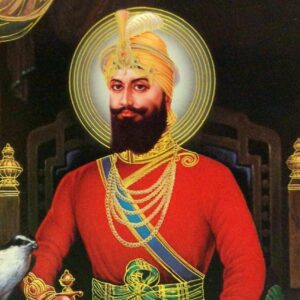Guru Gobind Singh was the tenth Guru. He was the only son of the ninth Sikh Guru Tegh Bahadur, who was killed by Mughal Emperor Aurangzeb. Aged just nine at the time of his father’s death, he succeeded him as the leader of the Sikhs at this youthful age. The events surrounding his father’s torture and execution greatly affected him. Being the guru at such a young age placed enormous duties on his shoulders, which he handled with unusual maturity. After Guru Tegh Bahadur’s death, the Sikhs were again called upon to resist Aurangzeb’s armies in order to safeguard the people from religious persecution. Gobind Singh was a valiant warrior who inspired his followers to fight and die for justice and freedom. He is credited with creating the Khalsa and introducing the Five Ks to Sikhism. He gave Bhai Mani Singh the Guru Granth Sahib and died leaving the Guruship to the holy scripture.
Early Childhood of Guru Gobind Singh
To Guru Tegh Bahadur and Gujri’s son Guru Gobind Singh was born on December 22, 1666. He was the couple’s only child, born Gobind Rai. Gobind Rai was born while his father, the 9th Sikh Guru, was preaching in Assam.
His father was a regular traveler and left his family with the local Raja. Tegh Bahadur traveled to Chak Nanki (Anandpur) in 1670 and invited his family.
In 1671, Gobind Rai traveled with his family through Danapur, where he began his basic education. Erudite in Persian and Sanskrit. In 1672, he and his mother moved to Anandpur to finish his schooling.
In early 1675, a group of Kashmiri Hindus fleeing the Mughals’ forcible conversion to Islam traveled to Anandpur seeking Guru Tegh Bahadur’s help. After learning of the Hindus’ misery, Guru Tegh Bahadur went to Delhi. Before leaving, he named his nine-year-old son Gobind Rai as the ninth Sikh guru.
Mughal officers arrested and imprisoned Guru Tegh Bahadur. He was forced to convert to Islam and tortured for refusing. The Guru, who refused to convert, was then publicly executed.
A Career of Guru Gobind Singh
In 1676, on Baisakhi (the yearly harvest festival), Gobind Rai was formally crowned Guru. Despite the immense sorrow he had recently experienced, he undertook the duty of Guruship with wisdom and maturity.
Given the difficult relations with the Mughals, he focused on building a large army of determined warriors willing to die for the noble cause of safeguarding humanity’s dignity.
He invited all Sikhs to Anandpur on April 13, 1699, Baisakhi. He dubbed the sweetened water he created at the assembly “Amrit” (nectar).
He then begged for volunteers who were willing to sacrifice their life for the Guru. Five men volunteered, and he gave them the Amrit, naming them the Khalsa, the body of baptized Sikhs, and giving them the surname Singh. Sikh through baptism, he took the Amrit and adopted the name “Gobind Singh”. Others were also initiated into Sikhism.
On the basis of the Five Ks, Guru Gobind Singh formed the Khalsa Sikh faith. A wooden comb, a metal bracelet, Kachera: a specific form of cotton underwear, and the strapped curved sword, Kirpan, were the five symbols.
Sikh warriors battled against the Mughal troops when Guru Gobind Singh founded the Khalsa order. He fought at the battles of Bhangani,
Nadaun, Guler, Nirmohgarh, Basoli, Anandpur, and Muktsar.
Many brave Sikh soldiers died in battle, including the Guru’s two eldest sons. His sons were abducted by the Mughals and compelled to become Muslims. The lads resisted and were slain by being bricked into a wall. Despite the loss of his sons, Guru Gobind Singh fought bravely on.
Battles between Sikhs and Mughals raged for the whole reign of Mughal Emperor Aurangzeb. After Aurangzeb’s death, his son Bahadur Shah ruled. Bahadur Shah admired Guru Gobind Singh and used to listen to him. Wazir Khan, the Nawab of Sirhind, disliked the monarch and Guru’s cordial relations and plotted to kill Guru Gobind Singh.
Grandiose of Guru Gobind Singh
On the religious side, Guru Gobind Singh established the Khalsa, the collective body of all initiated Sikhs accountable for all executive, military, and civic authority in Sikh society.
He finished the Guru Granth Sahib, a compilation of hymns (Shabad) or Baani describing God’s characteristics. The Granth is the Sikh holy scripture and comprises the teachings of the ten Sikh Gurus. On behalf of the holy text, Guru Gobind Singh acknowledged the sacred scripture as his successor.
Personal Life & Legacy
Various opinions exist on his married life. Others claim he was married three times, to Mata Jito, Mata Sundari, and Sahib Devi. He had four sons: Ajit, Jujhar, Zorawar, and Fateh.
Wazir Khan, the Nawab of Sirhind, despatched Jamshed Khan and Wasil Beg to kill the Guru in 1708. Jamshed Khan stabbed the Guru. A European surgeon healed the incision, but it reopened a few days later and bled excessively. Guru Gobind Singh, sensing his demise, named the Guru Granth Sahib as his heir. At 1708 he died in Nanded.
Estimated Net Worth
Guru is one of the wealthiest and most popular Religious Leaders. Guru Gobind Singh net worth is estimated at $1.5 Million by Wikipedia, Forbes, and Business Insider.


